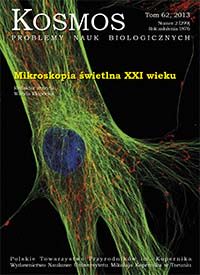Microscopic methods for recording of intracellular calcium responses
Abstract
Calcium ion is an important second messenger molecule for many various processes inside the cell, such as signalling, transcription, secretion, neurotransmission and apoptosis. Fluorescence microscopy with the use of calcium sensors is an indispensable method for our complete understanding of those processes. It enables accurate and fast (even in real-time) recording of changes in calcium concentration in individual cells in response to extracellular stimuli. This review article aims at getting the reader familiar with the basics of calcium homeostasis and the methodology to investigate it. Presented are the most important features of imaging systems used to monitor calcium levels. Subsequently, various types of as well as advantages and limitations of modern calcium sensors are discussed, in the context of current lines of scientific investigations. The future directions of research have been set and enabled by the intensively developed genetically-encoded calcium sensors, well suited for long-term monitoring of calcium responses in vivo in model organisms, such as mice.Downloads
Download data is not yet available.
Downloads
Published
2017-12-09
Issue
Section
Articles



